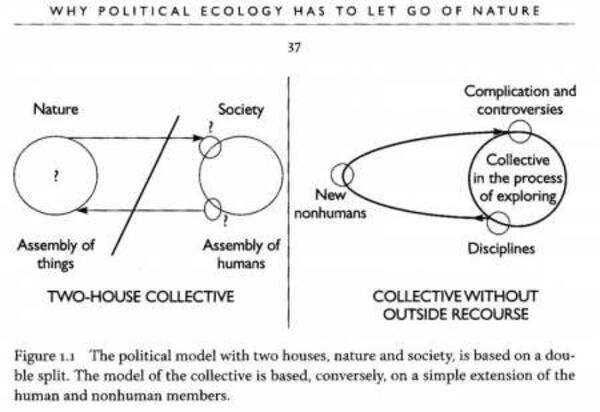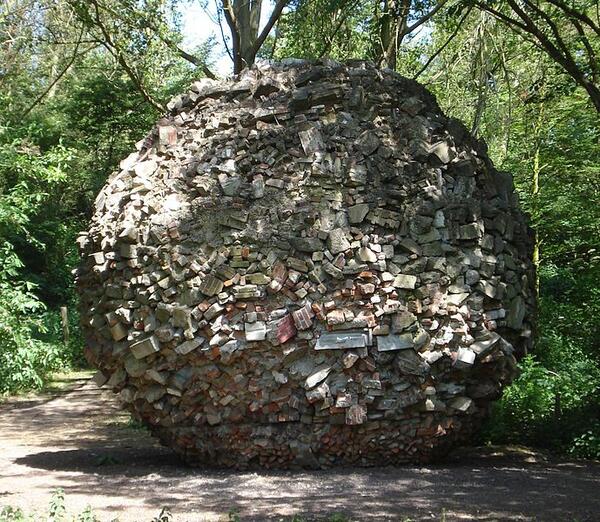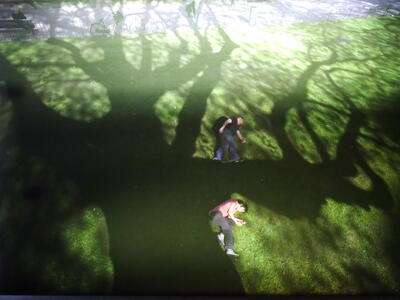project_groworld_general compost ArtScience
GroWorld Compost Heap: miscellaneous links, quotes, movies...
katarina
I found an interesting webpage, where some free-downloadable pdf files are. “Landscape For Life shows you how to work with nature in your garden, no matter where you live, whether you garden on a city or suburban lot, a 20–acre farm, or the common area of your condominium.”
mischa
Metalosis Maligna occurs when a metal implant interacts badly with human body tissue, causing the metal to grow tendrils, which eventually puncture the skin from within and destroy it. http://www.floriskaayk.com/work.html
cocky

Bruno Latour's 'Politics of Nature': The word Nature is more trouble than it is worth. As he exclaims ‘Thank God, nature is going to die. Yes, the great Pan is dead’ (p. 25). The diagram is all you need to think about to understand his entire argument.On the left we have the current political model. Nature is split off as something that requires the philosopher-scientist hero to go out into this hidden world of primary qualities and bring back precious knowledge. The natural world is set against culture as either a chaotic force that needs to be controlled (i.e. modernism) or mother nature is in balance and we need to become attuned to her laws so as not to destroy her and ourselves (Gaia spiritualism). We should not aim to marry culture and nature together, but to dissolve the distinction entirely.
On the right side of the diagram we can see what it means if we don’t split culture and nature and instead have a collective of non-human and human actants. The collective is in charge of collecting the multiplicity of associations between humans and non-humans. This is because the subject/object distinction has been removed and a politics proper can begin. review of politics by nature: http://avoidingthevoid.wordpress.com/2009/09/24/review-of-politics-of-nature-by-bruno-latour/
The Flower Orpheum frutescens has struck up an exclusive relationship with the carpenter bee. In order to get the tasty pollen the bee has to vibrate its wings at a particular frequency – middle C. These oscillations then make the flower open its stamens which releases the pollen, covering the bee in the fine yellow powder. This specific relationship ensures that the flowers’ pollen is taken by the carpenter bee to another flower of the same species, and so isn’t wasted. http://www.youtube.com/watch?v=cGKK7BRQHVQ
BBC series How to Grow a Planet. full episode 1 http://www.youtube.com/watch?v=1VNt0mwStZI
is based on the book “The Emerald Planet: How plants changed Earth's history” by David Beerlings. http://www.americanscientist.org/bookshelf/pub/plants-as-a-force-of-nature
via Arthur: Plants, animals and even bacteria go through a daily 24-hour routine, known as a circadian rhythm, which allow them to make tiny adjustments as daylight changes, and adapt to changing seasons http://www.bbc.co.uk/nature/17312132
mischa
I found an interesting article that reports on how to live a year without money, by becoming semi-self sustainable, which relates to a couple of projects:
ludmila
Ai Weiwei: Sunflower seeds: http://www.youtube.com/embed/PueYywpkJW8
After talking to Marloes and Mischa yesterday I came up with this Dutch documentary on a whole new thinking of design, recycling and the future of food. The theory cradle_to_cradle is based on 0% trash generation, 100% compostation of objects we produce, buy and throw away. According to the architect William McDonough and the chemist Michael Baumgart (the two authors of the cradle-to-cradle ideology) things have to go faster, easier and cleaner to the environment. Recycling as we know today isn't real, it's actually downcycling. Recycling is only true when things are really useful for the environment and as good enough for us as if was brand new.
It's by VPRO Tegenlicht, here is the link:
It's half English/half Dutch, worth watching anyway if you don't catch on so much Dutch, like me ;)
(thanks Mischa for the tip!)
art, people and nature together
7000 Oak Trees - in 1982 Joseph Beuys gathered the public of Documenta 7 to plant seven thousand oak trees in the city of Kassel, Germany.
More recently the artist Tom Russoti created the Institute for Asthletics (http://aesthletics.org), dedicated to playing sports as artistic practice; generating a a mixture of physical activity, social interaction, movement, performance, and ritual.
maja
I mentioned critical design as a method to encourage a visual discussion with an audience. Here's a good description of it:
And, somewhat related are the works of design fiction. difference being that critical design makes judgements and critiques status quo, design fiction is about making things that tell stories and tickle imagination… Perhaps something to inspire the 'glue group' - how to create an environment / experience that incorporates existing experiments in a story of a very different kind of future…
a basic plant sensing circuit for detecting moisture → http://www.faludi.com/2006/11/02/moisture-sensor-circuit/
Oblique strategies provides and example of a playful way to encourage people to do things differently:
Another example of cards that help people discuss complex future visions:
“They are the kind of activists who carry farming equipment not to symbolise the proletariat, but because they've got some serious hoeing to do. They're not mild-mannered; they're angry. And while they may be patient when it comes to buds flowering, when it comes to urban wastelands, unsustainable town planning, the food industry, unemployment, social exclusion and the relentless grey, grey, grey of our towns and cities they are extraordinarily feisty.”

Puinbal by Donald Duk 1976. Monument from broken down houses in the second worldwar in Kuikduin, The Hague. Ecolgist consider this giant ball as a microsphere with some rare plantspecies living on it. http://commons.wikimedia.org/wiki/File:Denhaag_kunstwerk_puinbal.jpg
cocky
online books:
- Ecovention: current art to transform ecologies http://greenmuseum.org/c/ecovention
- Oritur by Ivan Henriques. http://ivanhenriques.com/texts
blogs:
- Wilfried Hou je Bek. http://cryptoforest.blogspot.com/
- Next Nature: http://www.nextnature.net/
- Stalking the Wild : http://stalkingthewild.posterous.com/
you tube:
- Marcus Coates; Dawn Chorus; http://www.youtube.com/watch?v=PCCpnDtgxXk and Why Birds Sing. and the making of:http://www.youtube.com/watch?v=3VxUg_ciJks
- The strory of Stuff: http://www.youtube.com/watch?v=9GorqroigqM
related libarynth pages:
- how to make seedballs: seedballs
- compagnion planting: companion_planting
- basics of a plant guild, its layers and functions plant_guilds
- edible plants for a guild: edible_gardening
- pages related to plants, plant biology, chemistry, physics, culture, neurology etc. category_botany
- patabotany. patabotany
- on plant sensing/sensors: plant_sensing
reading notes books:
- Pattern Language. Christopher Alexander. pattern_language
- The Timeless Way of Building. Christopher Alexander. the_timeless_way_of_building
- Cradle to Cradle, Mc.Donough & Braungart.cradle_to_cradle
- One Straw Revoution. M. Fukuoka. fukuoka_gardening
- The Secret Life of Plants. P. Tompkins and C. Bird - secret_life_of_plants
documentary
The Secret life of Plants by David Attenborough volume 1-6 (volumes 1,2 and 3 are shown during the classes)
theun
some people:
- Brandon Ballangee: http://www.brandonballengee.com/
- Usman Haque: www.haque.co.uk/
- Chris Woebken: http://www.woebken.net/
- Natalie Jeremijenko: http://www.environmentalhealthclinic.net/people/natalie-jeremijenko/
Theun's presentation **Augemented Ecology**:
- can be downloaded here as PDF.

